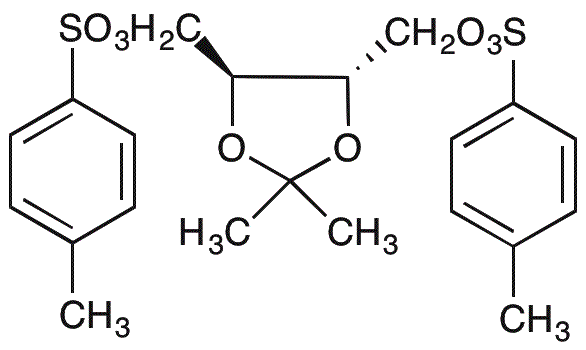(-)-1,4-Di-O-tosyl-2,3-O-isopropylidene-L-threitol is widely utilized in research focused on:
- Synthetic Organic Chemistry: This compound serves as a versatile intermediate in the synthesis of complex organic molecules, facilitating the creation of various pharmaceuticals and agrochemicals.
- Chiral Auxiliary Applications: It is employed as a chiral auxiliary in asymmetric synthesis, helping researchers produce enantiomerically pure compounds more efficiently, which is crucial in drug development.
- Bioconjugation Techniques: The compound is useful in bioconjugation processes, allowing for the attachment of biomolecules to surfaces or other molecules, enhancing the effectiveness of drug delivery systems.
- Research in Glycochemistry: It plays a role in the synthesis of glycosides and other carbohydrate derivatives, essential for studying biological processes and developing carbohydrate-based drugs.
- Analytical Chemistry: This chemical is used in the development of analytical methods for detecting and quantifying specific compounds, aiding in quality control and research applications.
General Information
Properties
Safety and Regulations
Applications
(-)-1,4-Di-O-tosyl-2,3-O-isopropylidene-L-threitol is widely utilized in research focused on:
- Synthetic Organic Chemistry: This compound serves as a versatile intermediate in the synthesis of complex organic molecules, facilitating the creation of various pharmaceuticals and agrochemicals.
- Chiral Auxiliary Applications: It is employed as a chiral auxiliary in asymmetric synthesis, helping researchers produce enantiomerically pure compounds more efficiently, which is crucial in drug development.
- Bioconjugation Techniques: The compound is useful in bioconjugation processes, allowing for the attachment of biomolecules to surfaces or other molecules, enhancing the effectiveness of drug delivery systems.
- Research in Glycochemistry: It plays a role in the synthesis of glycosides and other carbohydrate derivatives, essential for studying biological processes and developing carbohydrate-based drugs.
- Analytical Chemistry: This chemical is used in the development of analytical methods for detecting and quantifying specific compounds, aiding in quality control and research applications.
Documents
Safety Data Sheets (SDS)
The SDS provides comprehensive safety information on handling, storage, and disposal of the product.
Product Specification (PS)
The PS provides a comprehensive breakdown of the product’s properties, including chemical composition, physical state, purity, and storage requirements. It also details acceptable quality ranges and the product's intended applications.
Certificates of Analysis (COA)
Search for Certificates of Analysis (COA) by entering the products Lot Number. Lot and Batch Numbers can be found on a product’s label following the words ‘Lot’ or ‘Batch’.
Numéro de catalogue
Numéro de lot/série
Certificates Of Origin (COO)
This COO confirms the country where the product was manufactured, and also details the materials and components used in it and whether it is derived from natural, synthetic, or other specific sources. This certificate may be required for customs, trade, and regulatory compliance.
Numéro de catalogue
Numéro de lot/série
Safety Data Sheets (SDS)
The SDS provides comprehensive safety information on handling, storage, and disposal of the product.
DownloadProduct Specification (PS)
The PS provides a comprehensive breakdown of the product’s properties, including chemical composition, physical state, purity, and storage requirements. It also details acceptable quality ranges and the product's intended applications.
DownloadCertificates of Analysis (COA)
Search for Certificates of Analysis (COA) by entering the products Lot Number. Lot and Batch Numbers can be found on a product’s label following the words ‘Lot’ or ‘Batch’.
Numéro de catalogue
Numéro de lot/série
Certificates Of Origin (COO)
This COO confirms the country where the product was manufactured, and also details the materials and components used in it and whether it is derived from natural, synthetic, or other specific sources. This certificate may be required for customs, trade, and regulatory compliance.


